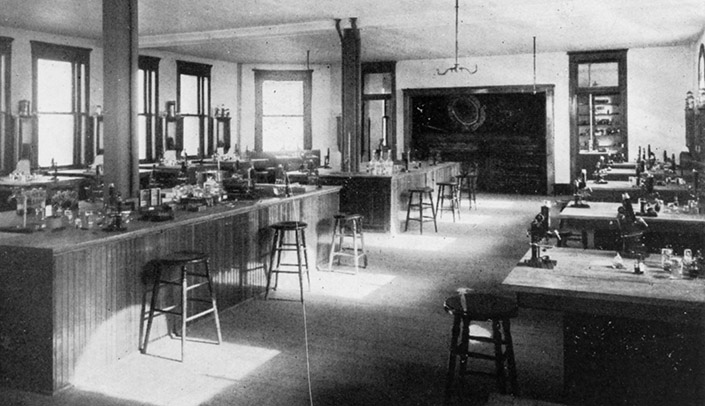Many things have changed on UNMC’s campus since the Omaha Medical College (OMC) opened its doors in 1881. One thing that has not changed is the university’s commitment to providing its students and faculty with state-of-the-art facilities and equipment.
In 1899, OMC completed an addition to its structure at the corner of 12th and Pacific Streets, nearly doubling the size of the building. OMC made many improvements to the facility, upgraded equipment, and created a structure that, according to the “OMC Pulse,” “exemplifies the twentieth-century idea of what should characterize an edifice of this kind.”
The OMC building was four stories tall with a full-size basement and all floors fitted with steam heat and electric lights. The first floor housed the student lobby and free dispensary. The dispensary, open every day except Sunday, contained a patient waiting room, drug room (pharmacy) and clinic rooms for examination and treatment. There was a dark room for eye, ear and throat examinations using lights, an ophthalmoscope and mirrors. Students were required to work at the dispensary to see the various clinical cases.
On the second floor, the library held 1,000 volumes of up-to-date textbooks and periodicals and included a reading room. A large amphitheater held audiences of 250. The X-ray room was used to study radiography and electro-therapeutics, as well as electricity and its application as a therapeutic agent.
The floor also housed a Morton-Wimhurst-Holtz static machine, a 10-plate machine (“the largest in the west”) with all of the attachments; a laboratory equipped to create dynamo currents regulated by rheostats and shunt currents, which could generate galvanic, faradic and static electricity; and a medical museum housing anatomical preparations of healthy, morbid and comparative anatomy.
The third floor housed a small amphitheater and a chemistry lab fitted with gas and running water. Able to accommodate 100 students, it was “the largest and most complete in the west.” The large dissecting room held 100 students. A refrigerating plant of a “modern design” allowed for preserving bodies for dissection. The room had excellent ventilation, and each table had two adjustable lights.
The fourth floor was set up for microscopic work, containing tables for mounting specimens and Bunsen burners. OMC purchased Bausch and Lomb microscopes fitted with double nose-pieces and iris diaphragms. Students used microtomes, an oven and sterilizers. Instructors used an apparatus that projected both lantern slides and microscopic sections onto a screen for ease of teaching.
Although the UNMC campus has undergone many changes since then, its commitment to the state-of-the-art has never changed.
